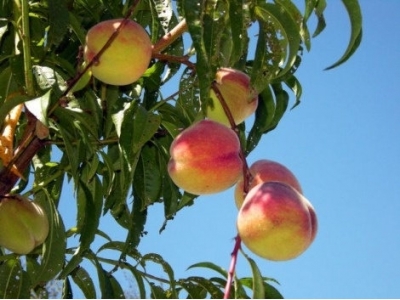Common Diseases of Peach Trees

Peach trees are notoriously susceptible to disease problems, especially during rainy, humid weather.
They’re also not particularly long-lived, and usually must be replaced after 10 to 15 years. However, if you live in a mild climate suitable for growing peach trees, the unbeatable flavor of a fresh peach makes them work the extra work. Below, you’ll find information about the most common peach tree diseases. In most cases, your best defense is a good offense, when it comes to treating peach tree diseases. Buy peach trees that are adapted for your region and resistant of the diseases common there. Plant them in full sun, in slightly sandy, well-draining soil. Prune them annually so light penetrates the canopy and air circulates freely. Finally, water peach trees regularly, because drought stress makes them more susceptible to problems.
Bacterial Spot
Bacterial spot is caused by the bacteria, Xanthomonas campestris pv. Pruni. This disease is difficult to control, but fortunately, it is rarely fatal and causes only cosmetic damage to the peaches. The first symptoms you’ll probably notice are purple or reddish spots on the leaves. In some cases, the leaves might yellow and drop. The fruit develops small brown spots that can usually be peeled away. There are no chemical treatments for bacterial spot, but it’s more prevalent on stressed trees. Keep peach trees healthy through proper watering, pruning and fertilization.
Brown Rot
Brown rot is the most common peach disease most home gardeners experience. Caused by the fungus, Monilinia fructicola, it first infects blossoms in spring. The blossoms turn brown and twigs may develop oozing cankers. Later in the season, it causes the developing fruit to turn brown, rot and become mummified on the branches. Spores in the infected blossoms, branches and fruit spread to infect other trees. Brown rot is most serious during wet weather, especially as the fruit is ripening. To control it, remove any infected flowers and fruit immediately and discard them. Pick up and dispose of all dropped fruit in the fall. You might also need to apply a fungicide containing captan, thiophanate methyl or azoxystrobin. Begin spraying as the first fruits start to ripen. If you wait until signs of rotting, you’ll have less success. Follow all directions carefully and spray the entire tree.
Crown Gall
This soil-borne disease is caused by a bacteria, Agrobacterium tumefaciens, which lives in the soil and infects many different species of ornamental and edible plants. You’ll first notice it as white or greenish growths under the soil or at the base of the tree. As the growths age, they spread and become brown or black. These growths interfere with the normal process of transferring nutrients between the roots and the tree. There is no treatment for crown gall. As the disease progresses, it stunts and eventually kills the tree. Plant disease-free trees. Avoid planting peach trees where crown gall has been a problem before. Be especially careful during planting not to injure the trunk or roots because crown gall enters the tree through injuries.
Gummosis
Aptly named, gummosis causes oozing, gummy sores or balls to form on the bark of the trees. You might also notice small blisters on the bark or sunken cankers. Over time, the disease, which is caused by the fungus, Botryosphaeria dothidea, weakens the tree and may eventually kill it. The problem is most prevalent on young, drought-stressed trees. There are no chemical controls for this disease. Keep the trees healthy and prune out any infected areas. Sterilize your pruning tools between cuts by dipping them in a solution of one part chlorine bleach to 10 parts water.
Peach Scab
Like bacterial spot, peach scab causes mostly cosmetic damage. It can be prevented with fungicide sprays, but for many home gardeners, ignoring it is the simplest option. Peach scab doesn’t cause damage to the leaves, but causes small, velvety spots on the fruit. In most cases, the spots can be peeled away and the fruit is perfectly edible. Peach scab is most common in young trees. To minimize the risk of peach scab, avoid planting peach trees in a low-lying spot. Water with soaker hoses instead of overhead sprinklers. Peach scab is most prevalent during rainy, mild weather.
Related news
 How to Grow Boxwood Shrubs
How to Grow Boxwood Shrubs With their small, evergreen leaves, boxwoods are most widely used as tightly clipped hedges, but they can be allowed to take a more natural form or clipped into
 Using Seedling Mats for Seed Germination Temperature
Using Seedling Mats for Seed Germination Temperature Starting your own plants from seeds is a great way to save money in the garden, but it's not always easy getting the right balance.
 How to Grow Carnations
How to Grow Carnations From prom corsages to elementary school science experiments, carnations (Dianthus caryophyllus) serve a myriad of purposes as cut flowers